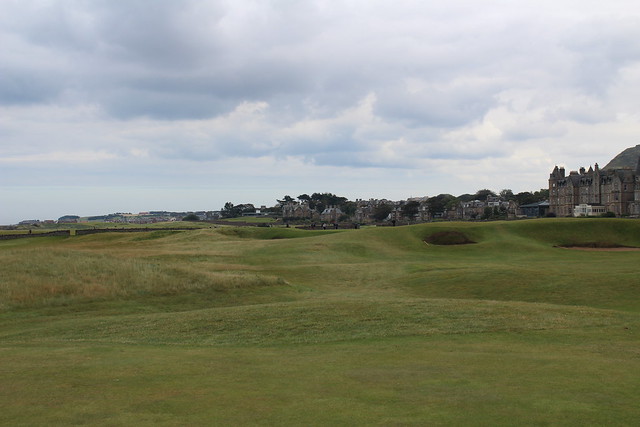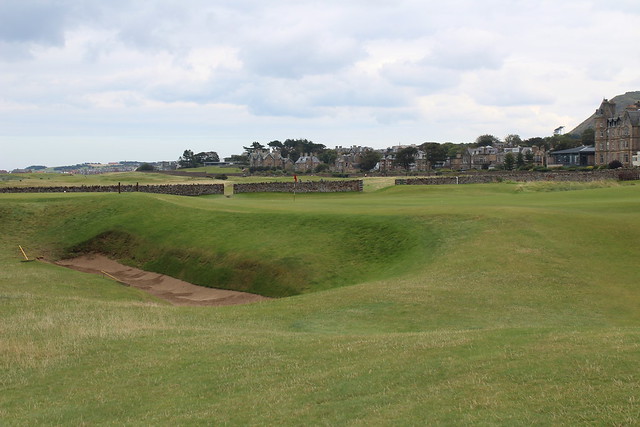
Sunday, December 24, 2006
Whose the Richest of Them All?

Thursday, December 14, 2006
Top 100 Golfer Podcast

Top 100 Golfer had the opportunity recently to be interviewed by Fred Greene who operates a golf podcast GolfSmarterPodcast.com, which is the #1 amateur sports podcast in the world.
Click below to listen to the interview which runs about 30 minutes. Once the main screen appears click on List of Podcasts and you will see the interview.
Top 100 Golfer Interview
Hopefully, I didn't give away too many secrets during the interview.
Friday, December 01, 2006
Inverness Club
Playing the top 100 has really given me a new perspective on life. Yes, I am truly excited to travel to Detroit and Toledo to play great golf. It really has forced me to have a more open mind. The Inverness Club (ranked #58 in the world) is located in a lovely neighborhood of Toledo not far from the University of Toledo.
Inverness is a Donald Ross gem originally designed in 1919. The course has been changed over the years by Arthur Hills and Tom Fazio as well. Byron Nelson served as the pro at Inverness at one time. Inverness has played host to six major championships - the U.S. Open in 1920, 1931, 1957 and 1979 and the P.G.A. Championship in 1986 and 1993. It also hosted the U.S. Amateur in 1973 won by Craig Stadler. Although the winners of the Opens at Inverness are not exactly household names (Edward Ray, Dick Mayer, Hale Irwin and Billy Burke) it is unquestionably a championship golf course.
If I had to sum up Inverness in two words: small greens. Inverness has the smallest greens of any golf course I have ever played. Almost every green is a postage stamp green.
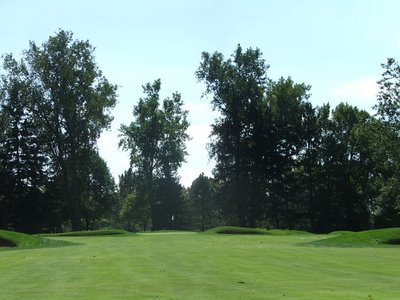
The approach to the 2nd green
Not only is each green very small, but the predominant design feature of the course is well guarded greens with narrow openings that require accurate approaches. Each green has either mounds on both sides or bunkers with high lips as you can see in the pictures above and below. It is a fairly easy driving course, with wide fairways. The trick at Inverness is getting on the greens in regulation. It requires very precise iron play.
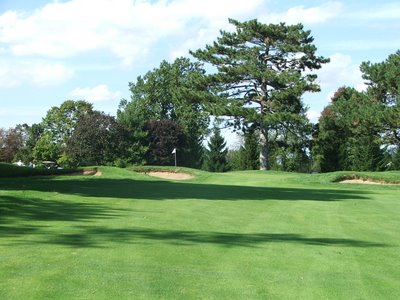 Approach to 8th green
Approach to 8th green 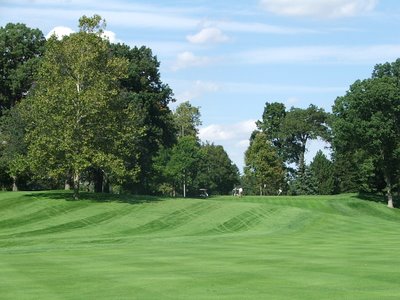 The approach to the 7th green
The approach to the 7th green As is customary in Ross's designs, Inverness has its fair share of holes with shaved areas around the small greens such as the one below on the 4th hole.
Sorry to disappoint, but no jokes about Toledo. It seems like a perfectly nice middle-America city to me. I very much enjoyed playing Inverness, although I didn't hit many of the greens in regulation. Inverness is another good example of how technology is ruining tournament golf. This gem of a course can no longer host professional tournaments because technology has made it too short, which is a shame.
Inverness is a private club and you are required to play with a member.
Sunday, November 19, 2006
North Berwick and Prestwick - The Cradle of Golf
Perhaps it is because the courses are too short - Prestwick is 6,554 yards and North Berwick 6,420. Or perhaps because they don't host championships any more, they are overlooked. Or perhaps those that rank the courses for the magazines sadly underweight history and tradition.
Both courses were clearly great 100 years ago. The famous British amateur champion of that era, Horace Hutchinson, wrote at the time - "A man is less likely to be contradicted in lauding Prestwick than in singing the praises of any other course in Christendom." The question is, are they still great courses today?
If you like courses with a lot of cement cart paths or if you like Donald Trump over-hyped golf courses, you won't appreciate these so you can stop reading now. If, however, you are a student of the game, appreciate tradition and want to have some of the best golfing experiences of your lifetime, I highly recommend both courses.
Prestwick Golf Club
Prestwick Golf Club, founded in 1851 is the birthplace of the Open Championship (British Open). The first Open was held at Prestwick in 1860 and was won by Old Tom Morris. Prestwick hosted the first 12 Open Championships and in total has hosted 24 Opens, second only to The Old Course at St. Andrews.
Playing at Prestwick is like going back in time. The course has a timeless feel to it and is hallowed ground for golfers.
The British golf writer Henry Longhurst has said of the first at Prestwick - "A tremendous wind is blowing and the slightest letting up will see your ball sailing away like a seagulls feather across the down platform of Prestwick station."

Fortunately, the trains are now all electric so we don't have to contend with cinders. But the sensation of playing the first hole remains with the modern golfer. Dell Leigh wrote eloquently about Prestwick's first hole in 1925, "Caddies, who have carried the clubs of champions, lean on the iron railings of their pen behind, taking stock of you. All along your right (or slicing hand), in terrible proximity, runs the railway line, over which rush whistle-blasting engines. Was it not Vardon who put his first two balls out of bounds on these same railway lines, and won the championship in spite of that?. Even if you play warily to the left here you have a grimly narrow opening to the green, and you are off the line of entry."
Detractors of Prestwick will tell you that they don't like the course because you can hit an iron off too many tees and granted, the eighteenth hole is a weak finishing hole. They will criticize the blind par three fifth hole, named Himalayas. The critics are wrong in my view. The place is worthy of being ranked among the top golf courses in the world. I will guarantee that you will think about Prestwick long after the memory of other courses fade. The sixteenth green, "Cardinal's Back":
The Alps hole is built on such a massive scale, it remains better than all attempts to copy it around the world. The seventeenth is seen greenside, below:
Pete Dye was also influenced by Prestwick where apparently he was inspired by the railway sleepers (ties as we call them in America) used to shore up bunkers. The course remains an important place in the history of the game and for this reason architects continue to study it.
Prestwick also allows you to appreciate its history to the fullest extent possible. If you book in advance, you can have lunch in the member dining room, shown below. You must wear a jacket and tie, and the hastle of changing into them is worth the trouble. You sit at a long table that seats 32 with dozens of pictures of past club captains in the dark green room. After lunch you can enjoy a Kummel (nasty) and a cigar as you contemplate your afternoon round and subliminally think - don't slice off that first tee.

North Berwick Golf Links
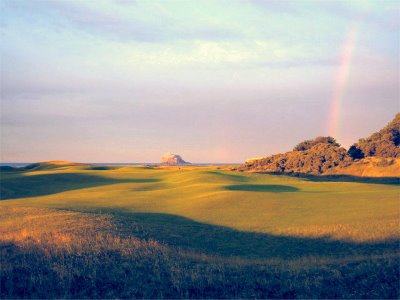
One of the defining features of the North Berwick West Links are the stone walls that are throughout the course. In several instances you have to hit your shots over the stone walls. On the 13th hole, a stone wall protects the green. If you hit your shot to the right (wrong?) spot on this hole you will have to either chip or putt off the green through an opening in the stone wall. It is a lot of fun.
The sixth hole is also a very good one. It is a short par four where more likely than not you will be hitting your second shot from a downhill lie, over a small burn to a green that slopes down to a burn that is hidden to the golfer off the tee.
The 16th hole, close to The Marine Hotel, which looms over the course from a promontory nearby, has one of the most interesting greens you will ever encounter. The green is bisected by a gully which creates two distinct tiers that are separated from one another. If your ball is on the wrong side of the gully, you will have a miniature-golf style putt. Think it's silly? It's not, it's a blast.
Hutchinson captured the essence of North Berwick and it still rings true today - "It is an exceptionally good school in which to learn the art of approaching." Clearly, at 6,420 yards, driving is not of paramount importance, but hitting good and often creative approach shots, is.
North Berwick, like Prestwick, does have some weak holes, most notably the first and finishing holes. Its detractors will tell you that it is not a good test of golf. No doubt, these detractors have never played the course when the wind is up, which is the real defense of links courses. There are few places in the world to play like North Berwick that are magical and will inspire you to keep going out again and again to play.
North Berwick Golf Club Web Site
Prestwick Golf Club Web Site
Credits: The sensational pictures with the sun shining in this posting that capture the spirit of North Berwick are from Golf Club Atlas.
Thursday, November 09, 2006
المدينة المنورة (Medinah Country Club)

I flew to Chicago for this?
The Club and Clubhouse
Medinah Country Club (ranked #52 in the world) is located in suburban Chicago. Medinah is a private member owned country club which has three golf courses featuring 640 acres of property and 18,000 trees. Medinah was founded in 1925 by the Shriners, who thought it would be interesting to build a clubhouse with an unusual style of architecture. The clubhouse is certainly one of the most unique in the world of golf at 60,000 square feet. It has an eclectic style evocative of the near east and contains elements of many architectural styles including Italian, Oriental, Louis XIV and Eastern. The club was named after the holy city of Islam in Saudi Arabia by the same name. Medinah is the second holiest city in Islam after Mecca and is famous for the presence of the shrine of Mohammad, known as the Green Dome, thus the likeness to the Medinah clubhouse. Like Mecca, Medinah permits only Muslins to enter. You can enter Medinah Country Club, however, if you are the guest of a member.
I am always excited about finally being able to play courses that have hosted major championships and that I have seen on TV. The clubhouse at Medinah displays its history to very good affect with memorabilia from Tiger's victories and many other historic pictures and collectables. The interior of the clubhouse is striking and it does impress, as you can see below.
 The Entry Foyer
The Entry FoyerAt 60,000 square feet, it has room for everything. The pictures below were taken in the ball room of the clubhouse that is quite grand; it even has a stage for performances.

I especially like the architectural detailing of the pilasters in the ball room seen above and below.
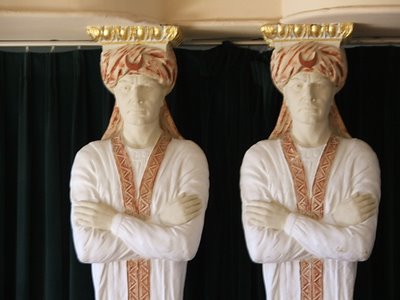
History of A Championship Course
All three courses at Medinah were designed by Tom Bendelow. The course has hosted the US Open three times (1949, 1975 and 1990), the PGA twice (1999 and 2006, both won by Tiger Woods) and will play host to the Ryder Cup in 2012. The #3 championship course is one of the longest in championship golf at 7,500+ yards. One of the key features of the course is the man-made Lake Kadijah that comes into play several times, including early in the round on the second hole, seen below.
 The par three second hole
The par three second hole Holy Shit!
Unfortunately, hosting a big tournament and a great golf course are two separate and unique things. Medinah is not a great golf course and is completely overrated. It suffers from the same thing Wentworth does - it's a great course to host a professional tournament - it can handle large crowds, etc., but the course has no personality and requires no imagination to play it. I am not taking anything away from the club and the PGA and USGA for hosting tournaments there; no doubt it's a great choice for what they are trying to achieve. The problem is, the course is weak. Certainly long, but weak when compared to the world's other great courses.
I found the par threes to be BORING. Holes 2, 13 and 17 are almost identical par threes. All require you to hit a tee shot over the man-made lake to an uninteresting green. By the time you get to the 17th tee you think to yourself, "This looks familiar." Actually, it is familiar since you've played near identical holes at #2 and #13. These are the signature holes?
The 10th hole is the least idyllic hole I have ever played in my life. At Maidstone you experience the Atlantic Ocean lapping along the sands. At Casa de Campo, the waves crash around you. At Crystal Downs you have the beautiful view of the countryside and lake below. At Medinah, you get the noise of US-20, which runs down the entire left side of the hole. The lovely tee box is shown below.
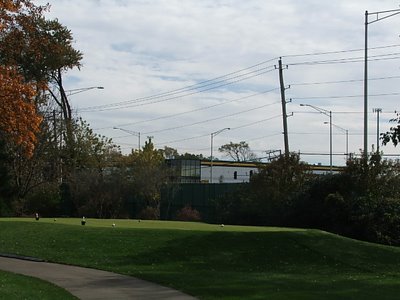
While playing this hole, it was so loud I couldn't even hear my playing partner when he spoke. The same din from the highway is present on the 15th green and 16th tee. The hole is actually a pretty good par five; you just can't appreciate it with all the noise.
Like Wentworth, the other issue I found at Medinah is that there are a lot of jets flying over head. It is apparently directly over a landing pattern for O'Hare. O'Hare has parallel runways and often times you will see not one, but two low-flying jets. Sometimes, planes can be charming when near a golf course. I have played both the Old Course at St. Andrews and Royal Dornoch with the sounds of RAF jets taking off and landing and found it actually added to the ambiance. At the Moray Golf Club in Scotland, a runway from RAF Lossiemouth. It is at the end of one of the fairways. I found it exhilirating to have a fighter jet take off occasionally. I didn't find that here, probably because a plane flew overhead about every 30 seconds all day. I took the picture below from the 12th fairway. Notice the landing gear down and the passengers waving to us below.

I found the course to be shitty the day I played. Not shitty in the figurative sense. Shitty in the literal sense. To be precise, shit from Canadian geese was everywhere. I'm sure there are times when the course is in immaculate condition. Unfortunately, I was not there during one of them. I'm sure I will be accused of being unfair, but I can only call it by what I see firsthand. If you will allow me the liberty to repeat myself for emphasis: There were turds on every tee box, there was feces in the fairways and there was poop on the putting greens. Lest I be accused of making this up, through the wonders of my digital camera I present as exhibit 'A' the 8th green seen below.
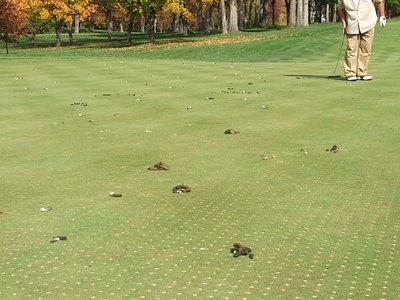
Why doesn't the course invest in some border collies and be done with the geese? We played this green at about 1:00pm, so there was plenty of time for the greenskeeping staff to clear it off. Perhaps they were pre-occupied with the squirrels. Several of the greens had fairly significant holes in them, apparently from squirrels who thought they would be a good place to bury acorns. I kid you not.
While I am not a golf course architect, I can sum up what's wrong with the course with an analysis of the 15th hole. A 392 yard par four, it has a large stand of trees on the left side of the fairway, some of which overhang, making an approach shot from the left side of the hole difficult. The bunkers were also put on the left side, under the trees, leaving the entire right side of the hole open, with no hazards. A drive to the right leaves a clear shot to the slightly elevated green. It doesn't take a genius to see that this is not brilliant design. It would probably have been better to put the bunkers on the right side of the fairway to cause the golfer to hit the ball left and thus have a more restricted shot at the green. Or to require a precise shot in the middle of the fairway. All you have to do is aim right and you're fine. My point is, when a layman notices stuff like that, it's probably not a sign of brilliance in architecture.
In the interest of fairness, the trees at Medinah are beautiful, and they do create a park-like effect overall. I found the 12th hole interesting; it has a big slope from the left side of the fairway to the right side the entire length of the hole as you can see if you look at the cart riding toward the green. The picture was taken from the green looking back.
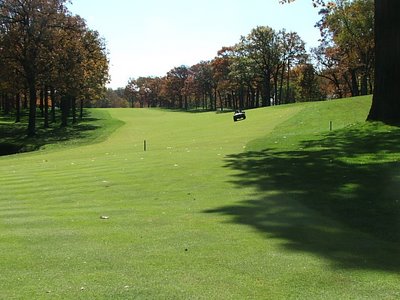
The 14th is an interesting par four with good use of the hilly terrain and a challenging shot to an elevated green. The 16th and 18th aren't bad and again are routed in an interesting fashion as are some of the elevated greens on the course, as pictured below.
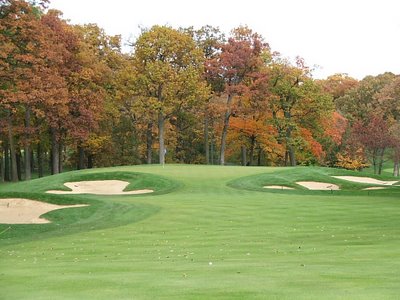
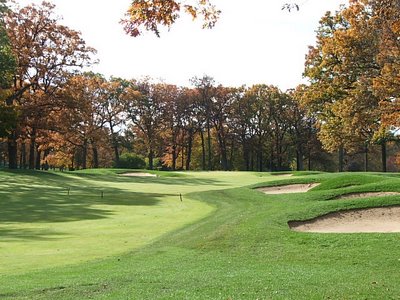
As you've probably guessed by now, I didn't like Medinah. I was actually so taken aback after playing that I actually had to double check that I indeed had played the championship course - #3, since Medinah has multiple courses.
Indeed, I had.
To make my day even more special, we were paired up with a "gentleman" who had gotten on the course as an unaccompanied guest through "a friend of a friend of a friend," as he put it. The "sausage king of Chicago", he was a local purveyor of fine meats stuffed in animal intestines. He did a perfectly good impression of Tony Soprano on the golf course. He rode in a cart, although he could certainly have used the exercise. He had a cell phone strapped to his belt and would occasionally talk into it walkie-talkie style to provide color commentary to his friends "Joey, I'm on the 14th tee at Medinah, you know what I mean?" He wore a button down shirt with the first six (of seven) buttons un-buttoned so you could see his lovely white tee shirt. And the shirt was intentionally not tucked in all day. Call me a snob if you like, but this pretty much sums up everything in golf I don't like in a playing partner. Thank goodness, at least he played fast.
If you go to play Medinah I suggest doing so during baseball season. Go to Wrigley Field and see a Cubs game so the trip won't be a total disappointment.
And be sure to scrub your hands very good after playing to remove all the fecal matter.
Thursday, October 26, 2006
Golf de Morfontaine - Vive la France?
 The 3rd hole at Morfontaine
The 3rd hole at MorfontaineAs I started this quest I made up a list of courses and broke them down into various categories - 'easy to get on', 'possible', 'difficult' and 'no clue'. The private courses in Japan go into the 'no clue' category as do several private US courses that I don't even have the remotest contact at. Morfontaine also goes into this category.
In an occasional series I will keep you appraised of how I am doing trying to get access to the course. Ranked #47 in the world, Morfontaine Golf Club is located in the Chantilly region of France, about 30 miles north of Paris and 10 miles south of Senlis. It has a reputation as being a very private club that visitors cannot play without a member. Or as they say in the native tongue: Club privé exclusivement réservé aux membres. I have heard great things about Morfontaine. It was designed in 1927 by Tom Simpson. I am a great admirer of other courses that Simpson has had a hand in - namely Cruden Bay and Ballybunion, so I thought this would be a good one to pick and attempt to play sooner rather than later.
 The clubhouse at Morfontaine
The clubhouse at MorfontaineFinding Golf Club de Morfontaine is not an easy task. I was able to obtain a picture of the clubhouse, shown above, from GolfClubAtlas.com. Again, in the local venacular, there is pas de site web to go online and find out information about the club and no email address. The closest I have found is a picture of the course from satellite. Click to see the Google maps. The hybrid or satellite view works best. aerial image of Golf Club de Morfontaine. If you look carefully you will see 27 holes. Nine holes were created in 1910 and an additional 18 holes, the world ranked course, in 1927.
In any event, I was able to locate the club's phone number (0033 344 54 68 27) so I figured I would just phone them up and see if they would let me come out and play. Mind you, this is not a completely irrational thing to do. After all, even such esteemed European courses such as Muirfield and Royal County Down will take your call and respond to your email and explain their booking procedures. Since I don't speak French, I had a French speaking female associate call on my behalf and see if we could politely book a tee time. I wanted to approach them with the utmost respect, which we did, and was completely flexible as to the date and time I was available to play.
Well, let's just say her inquiries were met with what can best be described as a chilly reception. I'm not sure of the exact English translation of what they told her but it's the rough equivalent of something that I can't print here. We were somewhat put off as this stance is so much at odds with the founding tenets of the French Republic - liberté, égalité, fraternité. After all - all the world's golfers share a fraternité do they not?
Well, at least we know where we stand.
Not easily put off I thought I would enlist the help of the American Embassy in Paris. This one I could do myself since they speak English. Morfontaine has long had a tradition of offering the current US ambassador a membership so they could play golf in the spirit of good relations. I'm not sure whether this tradition continues to this day, but I thought it was worth a shot. The US Ambassador would not take my call and I was transferred to the American Citizen Services Office of the Consular section which provides information and assistance to U.S. citizens in France. While the gentleman that took my call didn't tell me to go 'F' myself directly, he made it clear that he could be of no assistance.
Having struck out on the first two attempts it confirmed that this one was indeed going to be difficult. How exactly does one go about finding a member of Morfontaine? Before pursuing that I have one or two other ideas to pursue to find a way on.
I will let you know how I make out...
Click here for my 2007 writeup after playing the course.
Saturday, October 14, 2006
Crystal Downs Country Club
I found another hole to add to my list of unique and great golf holes in the world. The seventh hole pictured below has a tree in front of the green in the middle of the fairway. A well struck tee shot in the fairway requires you to hit over the tree onto a small undulating green. At 335 yards, you only have a short iron to the green, so it's a fair shot and genuine fun.
The seventh hole approach to the green, behind the tree
I also experienced the Mackenzie camouflage effect at Crystal Downs. I didn't find that I hit into many of the bunkers, but their presence really causes you to aim your shots in the wrong direction in a subtle way. On the 12th hole the tree that appears to be in the middle-to-right side of the fairway from the tee is amazingly on the left side of the fairway when you get up to it. On the 4th, 5th and 6th tee shots you almost don't know where to aim off the tee, there is such a mix of trees, bunkers, severe hills and native grasses.
How is it that Dr. Mackenzie got a commission to design a golf course in Northern Michigan in the 1927? Tom Doak, a Michigan resident and member of Crystal Downs, by the way, in his excellent book The Life and Work of Dr. Alister Mackenzie, tells the story. The men that wanted to build a course wrote to Robert Hunter who had just written a book about golf course architecture. It turned out to be a prescient move. Hunter did design work with Mackenzie and recommended him for the job. In a stroke of luck we should all now be thankful for, it turns out Mackenzie was completing his design of Cypress Point and had to make the journey across the U.S. to make his way back to England. He met up with Perry Maxwell en route (Maxwell did a lot of work in the lower midwest) and they made the trip up to Michigan. Mackenzie first met Maxwell a tour of the British Isles in 1923 and Maxwell told him to look him up if he ever came over to the States. Once again, the stars seemed to align for the creation of this great golf course. Upon seeing the land, Mackenzie said that in England they would call this type of land "downs". Since the course overlooks Crystal Lake, the course was named Crystal Downs.
Apparently Mackenzie designed the front nine and then left Maxwell in charge of the construction. Mackenzie made Maxwell his partner "East of the Mississippi" according to his company's letterhead. In any event, the front nine is the clearly harder of the two nines with more difficult greens. Maxwell apparently designed and built the back nine two years later. It's no wonder Doak named his golf course design firm Renaissance. He is indeed a renaissance man, being both a world class designer and a fantastic author.
I have always found people from Michigan staunchly defend and love their home state, almost more so than any other state in the Union. They are hugely supportive of their sports teams, especially their college football teams. Many live there, vacation there and then retire there. It's nice to see such pride in a place. I am happy to report that their pride of place is completely justified at Crystal Downs. It justly deserves its world ranking as one of the best golf courses in the world.
Saturday, September 30, 2006
Pine Valley Golf Club
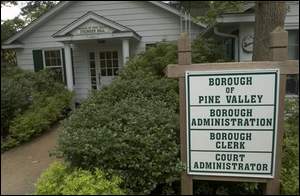
The Crump Cup
Pine Valley is a very difficult course to gain access to, however, they admit the public once a year to view the final day of the Crump Cup championship. They allow you to walk the course unescorted. The great thing is that there are normally only a handful of matches of the course and you are allowed to walk wherever you want and I generally choose to walk the holes ahead of the match and can usually do so in quiet isolation. I don’t have any pictures of the course to share because they don’t allow you to bring a camera. You are also not allowed in the pro shop or clubhouse. Nevertheless, it may be the only way some of us will ever see the course.
A Reader's Impression of Pine Valley
I am waiting until I play the course to provide my personal impressions of the experience but I would like to share with you the experience of a reader who wrote to me after playing the course a couple of weeks ago. His passion and excitement are reflected in his writing. I can’t wait to play.
"I just returned from a memorable East Coast Swing, albeit short - it was indeed sweet. I now can just sum up all of the top 100 questers in the world like yourself by stating it all ends at Pine Valley. I have now played about 30 top 100's (depending on which year’s list) and Pine Valley definitely stands alone. That includes all of the top 25's that I have seen. It is golf's Holy Grail. It is a Mecca of perfection from A to Z. It is simply the best experience on this planet. Experiencing it ranks number four in my lifetime achievements, behind my wedding and the birth of my two sons. It is not just the course, but the whole package. If you could ever dream up how does it right, just blueprint everything about the place. Starting with the property itself, continuing to clubhouse, the cottages, and the simplicity of what a true great golf experience should be. It has it all. I had the privilege of a Saturday night dinner (that was exceptional yet simple - New York strip med. rare, a fine Bordeaux, incredible pie for dessert) followed by Port and Cuban cigars on the terrace. I was the first to stay overnight in my room in the new cottage building.
Perfection again with a simple room designed only for a comfortable night's sleep (A members mattress company provided the beds and it is so comfortable - many members order them for their own houses). The room only includes a flat screen television and an incredible overhead shower. No locks on any doors, no telephones, nothing written anywhere re. rules, etc. So we awake to breakfast (a small buffet that appeases a simple early a.m. appetite) and then golf. A perfect driving range, large and immaculate, of course with Pro V-1s. Before our early a.m. tee off, I noticed the course workers dragging the fairways to remove the morning dew and dry the fairways. Wow. Have not seen that at Riviera, LACC or anywhere for that matter. Then 18 different holes of absolute perfection. Waste areas, waste areas, waste areas. Perfect fairways, perfect rough, perfect greens. A layout and routing unmatched by any course in the world. With due respect to Old Tom, H.S., C.B., Dr. Mackenzie, Tillie, Raynor and Thomas.........Mr. Crump is the greatest golf architect that ever lived. Pine Valley is all he needed.
The caddies there are as great and colorful as any lot at St. Andrews or Augusta. On the course they even address members by first names and nicknames. It is not about the pomp at Pine Valley, it is about the golf and the nirvana like experience. The only yardage markers you see are codes on a few sprinkler heads.....for the caddies. Wow. No smoking on the golf course. Yes! No rakes on the golf course. Brilliant! After playing many of the holes you may have heard about or seen pictures of in books, magazines, the Golf Atlas on the web, etc., you come to the 13th tee and finish with best of the best. What a string of six finishing holes. Awesome.
I love the fact that there are only 350 members. A perfect amount. And women are not allowed to set foot on the property until Sundays after 1:00 p.m. Annika herself who wanted to play there this year was resigned to only that brief window of time. Love it! Tiger has never seen the course, albeit he has been invited. Trevino played there for the first time last year. I feel blessed, and as if my life is complete having had the whole Pine Valley experience. Passing thru the gates one gets the feeling of achieving a physical and spiritual wholeness. It is truly AWESOME.
If you can, save it for last. Play it after 99 others. Then go to heaven. "
Sunday, August 27, 2006
Southern Hills and Prairie Dunes
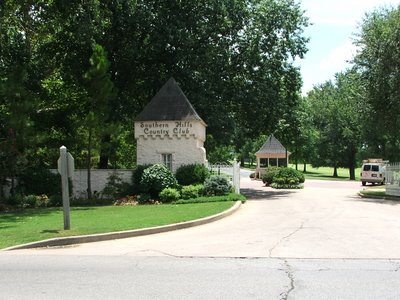


Sunday, August 13, 2006
The Teeth of the Dog - Golf in Hispaniola
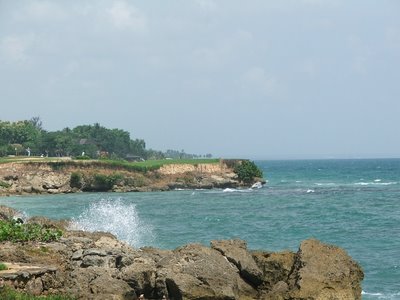
The Casa de Campo resort has three courses designed by Pete Dye: The Teeth of the Dog, Dye Fore and The Links. I recently played the world ranked Teeth of the Dog, which is now the fourth Pete Dye course I have played. Pete Dye has the second highest number of courses on the top 100 list, with eight to his credit. Only Alister Mackenzie has more. Dye designed The Teeth of the Dog in 1971 and it is his most highly rated course. He has been tinkering with it on and off for years since he resides part of the year in the Dominican Republic. The term "Teeth of the Dog" is derived from the term locals give to the coral rock the course is built on. Casa de Campo means "Country House" in Spanish.
Arriving in the capital, Santo Domingo, a city of 2.5 million people, you immediately know that you have left the developed world. It is a chaotic place. The first sensation that hits you is the high humidity, followed closely by the smell of exhaust fumes. The dominant style of architecture is the tin-roofed house. Almost all the motor vehicles on the island spew toxic fumes. There are stray dogs roaming the streets. There appears to be no set traffic patterns with cars moving in all directions, criss-crossed by motorbikes and motor-scooters crossing the roads at random. The Casa de Campo resort is about an hour and twenty minute drive from Santo Domingo. As you drive through the countryside you notice a fairly heavy police presence with scattered armed troops standing guard in various towns. There are street vendors selling water, chicken, bananas and many other products by the roadside. The presidential motorcade drove past us going in the other direction as we were driving to Casa de Campo. It just seemed a bit too long and dramatic to me for such a small country. Although the Dominican Republic has a sort-of representative democracy, the place had a banana republic feel to it. I also found curiously that almost no-one on the island speaks much English. I'm not complaining per se. It is a Spanish speaking country and I don't want to be accused of being a gringo, but it did make communicating more difficult.
The Golf Course
In any event, I finally made it to the course and teed off with a caddie. As we were waiting to tee off, I was making idle chatter with him. "What month do you get the most visitors?" I asked. His reply of "Yes" set the stage for the round ahead. His English was about as good as my Spanish so we made the perfect combination. We were able to establish on the first green that either the next hole was a par five or that he had five children. I'm still not sure which.
He asked whether I had any children (I think) and I said two, to which his reply was "Baseball," a phrase he would repeat often while making a mock swing at a baseball.
As I think I have mentioned before, as a golfer who grew up in a Northern climate, I don't adjust particularly well to playing on Bermuda grass. This was especially evident to my caddie when I smashed a birdie putt on the second hole well past the hole to his cries of mucho rapido. I already think too much when playing golf. Adding in an additional factor such as which way the grain of the Bermuda greens is going just taxes me too much.
After the 4th hole he kept saying the number eight repeatedly. I'm not sure he was implying that I should have taken an eight on the previous hole to account for the lost ball or that one of his sons was eight years old. And so it went.

I began to see the merits of his language when I hit my tee shot on the 7th hole, a par three. I didn't need a translator to tell me that shouting muy bueno, meant it was a good shot.

I liked the seventh hole the best. It is a 188 yard par three with both the tee and green set in the water. Many holes in the world are right near or above the water. What makes this hole unique is that you are right at sea level. At Pebble Beach or Turnberry for example, you are up above the water. As you stand on the tee on this hole, water is crashing immediately behind you, to the side of you and ahead of you directly on the same level you are standing.
On the 8th tee, we saw a fisherman going by in his boat. I was able to ascertain that either Pete Dye himself would be fishing off this hole tomorrow or that the caddie liked fishing. Given our little language barrier, I will never know for sure.
My caddie and I were getting on quite well and I thought we were finally sympatico. Although when I hit a high slice on my second shot on the 17th hole into the water, I thought I heard him say something about a banana ball.

To recap the course routing, the first four are inland, five through eight are along the water. After playing along the water, holes 9-14 go back inland and are decent if not great holes. You again hug the ocean on holes 15 through 17 and 18 is an uphill hole away from the water. I would say that Dye has done a good job with an imaginative routing and some really great water holes. The course does have features typical of a Pete Dye design such as waste bunkers and elevated greens. Look at the sloping behind the green at the 7th hole (shown below) as an example. I do notice that in the most recent world rankings the course has slipped to a lower number and I would have to agree with that assessment. While it certainly deserves to be ranked among the world's best, I think it's ranked a bit too high at the moment. I am still agnostic on Pete Dye as a designer and would like to finish playing all his courses before drawing a final opinion.
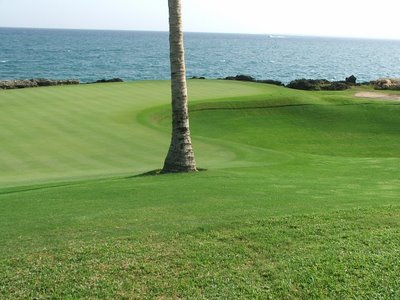
I think part of the issue with a Pete Dye design is that he designs for the signature hole, sometimes leaving other holes lacking. I found this to be true here at Casa de Campo, where the water holes shine and the others do not. It is certainly true at TPC at Sawgrass where the front nine has three or four really mediocre holes offset by the signature 17th and 18th. Much the same at Whistling Straits.
I have traveled extensively in the Caribbean and played golf on about nine different islands. I would say this is the best course in the Caribbean, although I think the best hole in all the Islands is C.B. Macdonald's #5, the Cape hole at the Mid Ocean Club in Bermuda.
I had a scheduled 7:00 am flight out of Santo Domingo on my day of departure. Given the distance that the resort is from the airport, the car service they had arranged was to pick me up at 3:30 am so that I could get to the airport on time and through the difficult new security lines. After going through one of the little towns in route we were driving in near total darkness when the driver began to slow down. I didn't see it until he almost hit one of the soldiers, but there was a troop carrier off to the side of the road and eight armed soldiers checking any cars that were driving by. The soliers were dressed in green and brown camouflage uniforms and there were no street lights or other signs of civilization. The clock in the minivan was precisely 4:00 am. I remember this for a certainty because I thought my remaining time left on this planet was approaching rapidly. The driver had a discussion in Spanish with one of the soldiers for about two minutes. Given the language barrier, I was again unable to comprehend what it was about, although he said money. Perhaps an un-official toll plaza setup by some enterprising soldiers? Whatever it was, it is at times like this that I question whether trying to play all these courses is really a sane venture.
Would I recommend going to Casa de Campo? Well, that depends. St. Barts, this is not. I would set your expectations low, drink bottled water without ice when you are there and travel in groups. The resort itself is nice and the golf is very good. The people are friendly, the prices are reasonable and Dominican cigars are very good. The course itself was in great shape which is quite an achievement within a tropical climate.
I do strongly recommend taking an afternoon flight out if you can get one, however. Or alternatively, take a smaller plane from San Juan into a new regional airport, La Romana, right next to the resort and bypass Santo Domingo.





